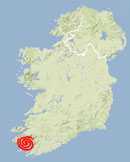03 May Baslicon Dolmen
“When Lugaid, son of Ith, was bathing in the lake, and Fial, daughter of Mil, his wife was bathing in the river that flows out of the lake, Lugaid went to the place where was the woman, he being naked; and then she looked on him. Thus she died of shame at once, and from her is named the river with its creek. Downcast was Lugaid after the woman’s death…”
Leabhar Gabhála Éireann (The Book of Invasions), eleventh century1
This low portal tomb two km (1.5 mi) south of Waterville is said to be the grave of Fial, this mythological woman of modesty. A local schoolteacher, Mrs. O’Shea, retells the story in a 1979 interview (below right).
Fial’s husband, Lugaid, was part of the invasion force attacking Ireland in retaliation for the Tuatha Dé Danann kings who murderd his father, Ith.2
Fial’s final bath came after her people, the Milesians, landed on this coast during this military expedition. This was the last of the series of conquests of Ireland depicted in The Book of Invasions (Lebor Gabála Érenn).3
While the putative date of this Milesian invasion was 1,000 BCE, archaeologists would argue that the dolmen, now called a portal tomb, dates from the Neolithic period, as early as 3,500 BCE. It is difficult to know what parts of its legend, not assembled in written form until the eleventh century, may reflect the oral traditions of the Iron-Age warrior culture and what parts of it may be a Christian gloss upon the earlier stories. Indeed, one meaning in Irish of the woman’s name “Fial,” is “modest.”4
Certainly modesty was a trait held in high esteem by the later ecclesiastical authorities, who could point to the mythological tradition as a validation of their moral system in contrast to what may have been the immodest excesses of earlier pagan practices. Much later, in the eighteenth century’s pre-romantic Celtic revival, it was understood as a political act to adopt the notions of Gaelic antiquity, even those that may have been a “pseudo-historical contrivance,” and understand them as a legitimate patrimony.5
We do know that Fial’s father, Mil, was the eponymous ancestor of all the Milesians, the invading Spanish tribe who in legend began the racial strain of today’s Irish. But the story tells us nothing else about Fial. It is said that while bathing in the river she did not recognize that the naked warrior about to join her in the water was actually Lugaid, her husband. Her shame as her nude form was seen by an equally exposed man she presumed was a stranger was so profound that it caused her to collapse and die. After Fial’s sudden death Lugaid was moved to compose these verses:
“Sit we here over the strand,
Stormy the cold;
Chattering in my teeth, — a great tragedy
Is the tragedy that has reached me.
I tell you a woman has died,
Whom fame magnifies;
Fial her name, from a warrior’s nakedness
Upon the clean gravel.A great death is the death that has reached me,
Harshly prostrated me;
The nakedness of her husband, she looked upon him
Who rested here.” 6
The virtual-reality environment (above) begins at the portal tomb said to be Fial’s monument. A hotspot will link to a large flagstone at the other end of the field.
The preservation of the Baslicon Slab, explains Michael Moriarty, was in part due to the folk beliefs of the area.
This stone, according to local lore, has on its surface a mark said to be made by Fionn Mac Cumhail when he slammed his hand down onto the rock. This story is contained in the video of Michael Moriarty, below left, recorded in 1979.
As is the case with monuments throughout Ireland, when connected to folklore a stone is considered deserving of special protection. Certainly removing the stone would have made the field more useful for agriculture. But when the other large stones in the field were bulldozed away, this one was never touched. The townland named here, Baslicon, is translated as “palm of the hand.”7
Just north of this location are the four Eightercua Alignment stones, also connected in legend to the invasion force. Other visitors to this area may have heard different tales, based also on the place-name stories in the mythological histories of Ireland. In a nineteenth-century travel journal published as a tourist’s guide to Ireland, the Baslicon portal tomb, here labeled an altar, was ascribed to a different warrior of the invading Milesians:
“I then left the road to see another Pagan monument, which has also a fine view over the Skelligs and Ballinskelligs bay, and of the rocks near its mouth, where, according to the tradition of the surrounding peasantry, Irr, the son of Milesius, was drowned in attempting to land. Hence they say that the name Ireland has originated: that the other brothers, with their followers from Spain, succeeded in landing, and subsequently obtained possession of the country: and that from gratitude for their conquest, they erected those altars which are so often seen in this part of the island.” 8
Click here to see all the notes from this page.
Baslicon Dolmen, Co. Kerry
Nearest Town: Waterville
Townland: Baslicon
Latitude: 51° 48′ 36.65″ N
Longitude: 10° 9′ 29.64″ W



